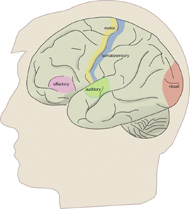 4) Functions can be localized in the brain (Bouillaud – 1825, Broca – 1861, Fritsch & Hitzig – 1870)
4) Functions can be localized in the brain (Bouillaud – 1825, Broca – 1861, Fritsch & Hitzig – 1870)
Bouillaud and Broca discovered patients with frontal cortex lesions who had speech problems. Fritsch & Hitzig discovered primary motor cortex; a specialized chunk of cortex specifically for motor control. Broca believed that all brain functions would be localized eventually, and held the brain area he discovered (now termed Broca's area) as an example. It was found that all sensory modalities have dedicated chunks of cortex, called primary sensory areas.
This localized function insight immediately clashed with the distributed function insight (see yesterday's post). Flourens and his followers were adamantly against the localizationist view championed by Broca and others.
The origin of the concept of localizing brain function, phrenology, added discredit to the practice. Phrenology claimed that differences in localized brain function were reflected in bumps on individuals' skulls. Once it was clear that phrenological findings were not replicated between individuals the practice was labeled a pseudoscience. Unfortunately, localization of function applied without the fallacies of phrenology was not spared the renewed skepticism of many scientists.
Today localization of function is well established, especially in primary sensory-motor regions. Functions have also been localized within association cortex, though much work remains in understanding how such localization arises. Insights within the last 20 years have led to a more sophisticated view of how functions arise in association cortex involving network interactions (see future insight posts).
Implication: The mind is implemented in an electric organ with distributed and modular function.
[This post is part of a series chronicling history's top brain computation insights (see the first of the series for a detailed description)]
-MC

By the way, notice the primary sensory-motor cortices in the post’s figure. Looks like ~10% (maybe a bit more) of the brain, right? P.L. mentioned that this might be the basis of the “we only use 10% of our brain” myth. The popular (and incorrect) interpretation of Lashley’s work (see yesterday’s post) was that only the primary sensory-motor regions are necessary. This is not true in the least. Association cortex is the seat of most cognition, and we would not be ourselves without it.